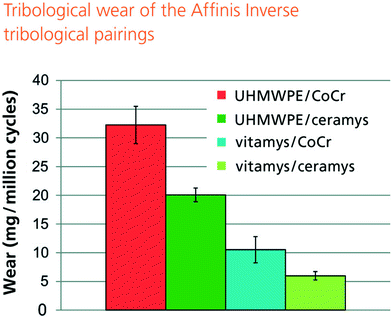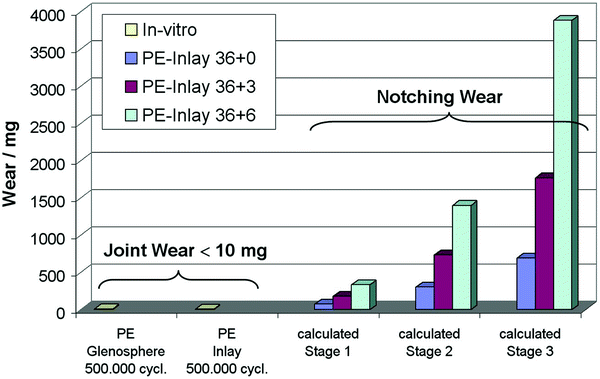Fig. 42.1
Affinis® Inverse
It is intended for treatment of massive and irreparable rotator cuff defects in combination with glenohumeral arthritis and revision after failed hemi- or total prosthesis.
The Affinis Inverse system consists of a series of cemented and uncemented standard and long stems, inlays, inlay spacer, glenospheres, baseplate, revision baseplate, head adaptor as well as locking and lag screws.
During the development period from 2004 to 2006, the knowledge base was given by the Grammont design as well as correlative biomechanical and clinical studies [3, 4, 12, 21].
General goals of a development are to keep proven features from former generations and exclude causes of failure, but not at the expense of proven features. As few features as possible should be changed, to enable a reproducible follow-up in comparison to the former generation. All components need to be able to be revised by a safe surgical approach as well as appropriate application of force during revision. Therefore, for example, a hard—hard coupling glenosphere/baseplate by a cold-molded Morse taper fixation was excluded from the beginning.
Another very important basic requirement was to provide a manageable system with a clear implant philosophy and a straightforward surgical technique.
Proven Grammont parameter
From a simple mechanical point of view a reduced neck-shaft inclination, an increased glenosphere offset and a reduced inlay cup depth are decisive design parameters to reduce inferior scapular notching.
Given the complexity of the biomechanical system of the glenohumeral joint and clinical experience, these parameters were assessed as sensitive concerning dislocation and implant loosening [4, 12, 13]. In a subsequent study, it was confirmed that reduced neck-shaft inclination and reduced inlay cup depth may result in reduced stability, whereas an increased glenosphere offset may result in an increased incidence of glenoid component loosening due to the “rocking horse” phenomenon [11].
Overall, the benefit–risk analysis showed no justification for modifications of these sensitive design features. Particularly with regard to the clinical and radiographical outcome, an inferior position of the glenoid component is more efficient to prevent inferior notching than changing other design features.
Therefore, the neck-shaft inclination of 155°, the center of rotation at the glenoid bone–prosthesis interface, and the inlay cup depth were defined as unchangeable according to Grammont’s concept.
Failure Analysis of Grammont’s Prosthesis
The main causes of failure that were detected were instability, infections, humeral and glenoid component loosening, component disconnections, and periprosthetic humeral fractures [3, 21].
Further complications such as stress fractures (e.g., acromial fractures), intraoperative glenoid fractures, wound hematoma, and axillary nerve palsy can also be related to implant design or surgical technique and had to be taken into account [3, 21].
The main problem—the glenoid component fixation and positioning in combination with the notching phenomenon of the humeral inlay with the scapula—was the initial challenge for developing the next generation of prosthesis.
Rationale for the Affinis Inverse System
The main modifications are a new 2-peg baseplate fixation without an inferior screw and the inversion of the bearing materials.
Baseplate Fixation
The modification of the baseplate design resulted from the conflict of goals with the conventional baseplate with one peg and an inferior screw. On the one hand, the baseplate has to be positioned as inferiorly as possible to prevent notching. On the other hand—in this inferior position—the inclined inferior screw is difficult to place in the scapular neck and there is a systematic potential of implant-implant notching between the screw and the humeral inlay. The inferior screw of the Grammont prosthesis was routinely positioned less inclined or parallel to the central peg to prevent implant–implant contact.
Consequently, a second peg with an appropriate stability and length was designed and the inferior screw was eliminated for the primary baseplate. A double coating on the backside consisting of a rough titanium plasma spray, and a bioactive calcium phosphate coating supports the primary and secondary stability.
With the Grammont baseplate with one peg, the anterior and superior screws are positioned rather far outside the center of glenoid and therefore often do not have an appropriate fit in the bone. With the two-peg design, the anterior and posterior lag screws can be positioned closer to the center and therefore have an improved bony anchorage.
With these modifications and a comparable primary anchorage stability to the conventional baseplates, the danger of malpositioned or broken inferior screws as well as implant–implant notching is eliminated.
Inverted Bearing Material
The common reverse total shoulder arthroplasty (RTSA) has “soft” polyethylene (UHMWPE) inlays and “hard” cobalt–chromium (CoCr) glenospheres.
In inverted bearing reverse total shoulder arthroplasty (IB-RTSA), such as the Affinis Inverse (Fig. 42.1), the humeral inlays are made from metal or ceramic and the glenospheres from PE.
The notching phenomenon of a “hard” and wear-resistant humeral inlay with the scapula results in a different characteristic. Excessive abrasive wear on the scapular bone, respectively, PE-induced osteolysis is eliminated. With the humeral inlay made from metal or ceramic, the characteristic remains with a simple mechanical notching [5].
Further Modifications
Concerning the high rates of infection and of glenosphere disassembly, the goal was to optimize the fixation of the glenosphere to the baseplate and to reduce the complexity as well as hollows inside the glenoid module [3, 17, 21]. Thus, the Affinis Inverse glenosphere was designed as a monolithic component, easy to clean and with minimized hollows.
The benefit of having a modular primary stem with the possibility of posterior offset adjustments to reduce proximal humeral bone loss and to optimize tensioning was considered, although a clinical relevance was not proven at this time.
After a benefit–risk analysis, due to the high rates of humeral disassembly, humeral radiolucencies and periprosthetic fractures of modular stems, it was decided to have monolithic stems with a continuous triple taper design [3, 18, 21]. With the inverted bearing and the hard humeral inlay, it was possible to reduce the wall thickness at the humeral components significantly, and therefore, the humeral bone loss could be reduced.
The bearing diameter 36 and 42 mm was proven as minimum and maximum sizes, but often the step between 36 and 42 mm was too big. Hence, a third size in between (39) was introduced to get more options for an improved soft tissue balancing.
In combination with an eccentricity within the baseplate design, an inferior overhang of the glenosphere of 4.0 mm for size 36, 5.5 mm for size 39 and 7 mm for size 42 results, if the inferior rim of the baseplate is positioned flush with the inferior border of the glenoid.
Affinis Fracture Inverse
In addition to the primary Affinis Inverse system, a reversed fracture central part was developed (Fig. 42.2). Contrary to delicate modular uncemented stem systems, the increased dimensions of the modular trauma system as well as the cemented stem fixation allow a safe fixation of the implant. Besides using it for primary fracture reverse treatment, it is possible to use the central part to switch from the anatomic fracture prosthesis to the fracture reverse prosthesis by leaving the stem in situ [20, 24].


Fig. 42.2
Affinis® Fracture Inverse
Due to the fixation mechanism with freely adjustable height and retrotorsion, it is possible to readjust the prosthesis. This is important especially for an adapted retrotorsion during the revision procedure from an anatomic to a reversed prosthesis.
Improved Bearing
In 2014, with the aim of optimizing wear characteristics, ceramys® inlays and vitamys® glenospheres were added to the system.
vitamys® is a highly cross-linked, wear-resistant polyethylene of the second generation that is permanently protected against oxidization aging through the addition of 0.1 % a-tocopherol (vitamin E).
ceramys® is a high-performance ceramic comprising a nano-crystalline dispersion of 80 % stabilized zirconium oxide and 20 % aluminum oxide, which lend this type of ceramic exceptionally high resilience and durability.
The wear reduction of the best possible pairing, vitamys/ceramys, versus the CoCr/UHMWPE pairing, is approximately 80 % (see Fig. 42.3 [6, 7]).


Fig. 42.3
Wear of the Affinis Inverse tribological pairings
In addition to reduced wear, patients can also benefit from a nickel-free option. With stems, baseplates, and screws made from titanium, polyethylene glenospheres, and ceramic inlays, the complete reverse prosthesis system is free of CoCr and hence of nickel.
The controversial debate about the allergic reactions from implants containing nickel (such as CoCr) continues to be waged [22, 23]. The growing demand for ceramic as a material indicates that it is important for both surgeons and patients to avoid allergy as a complicating factor from the beginning. With ceramic, an option in case allergies develop is offered.
Essential Biomechanical and Post Market Clinical Follow-up Studies
Gravimetric Wear Study on Standard and Inverted Bearing [16]
On an experimental setup, the gravimetric wear of both pairings, metal glenosphere versus PE inlay and PE glenosphere versus metal inlay, was measured. The wear tests were based on the standardized gravimetric wear tests for hip prosthesis (ISO 14242-1, 2002; ISO14242-2, 2000), with shoulder-specific load adaption up to 1000 N.
In addition, the abrasion of the PE inlay due to mechanical notching was calculated by means of three-dimensional CAD models for different stages of notching.
The loss of mass due to gravimetric wear was compared to the loss of mass caused by inferior notching.
The results of this study indicate that the gravimetric PE wear is low and not significantly different between both material configurations (see Fig. 42.4). However, the PE abrasion due to notching of a PE inlay on the scapular neck is much higher than any gravimetric wear. These results support the continued use of inverted bearing in RTSA.
Micromotions 1-peg Versus 2-peg Baseplate [8]
Biomechanical assessment of primary stability of the glenoid component was carried out according to ASTM F-2028-08 [1]. Two types were examined: a baseplate with one peg and four screws, including an inferior screw (Grammont concept), and a baseplate with two pegs and three screws, without inferior screw (Affinis Inverse design).
The baseplates were fixed in solid foam blocks (Sawbones Sweden, #1522-04) according to ASTM F1839-97 [2]. Further, special characteristics were as follows: testing and online measurement in a liquid medium, measurement of the micromotions at two measuring points (superior and inferior), testing up to 100,000 cycles, and a characteristic curve registration of the micromotions from 0 to 100,000 cycles.
Stay updated, free articles. Join our Telegram channel

Full access? Get Clinical Tree









